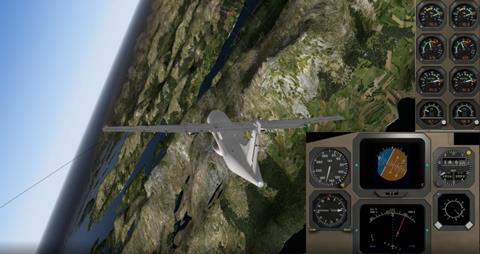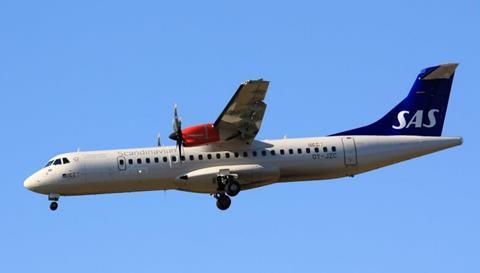Norwegian investigators have disclosed that an ATR 72-600 suffered a serious loss of control, with excessive wing bank, as its crew belatedly attempted to escape from icing conditions during a domestic Bergen-Alesund service.
The inquiry into the incident – involving a Jet Time flight for SAS on 14 November 2016 – found that the pilots were prepared for moderate icing, had activated the ice-protection systems, and were paying attention to ice accretion as the aircraft climbed through 10,000ft on its way to 19,000ft.
Although the icing intensified as the aircraft climbed, the crew had been expecting it to decrease above 14,000ft.
Norwegian accident investigation authority SHT says the crew seemed “surprised” that, instead, the icing worsened with altitude.
It suggests the crew had not acquired sufficient knowledge of the situation north of Bergen, where icing could be expected up to 20,000ft, pointing out that the planned cruise at 19,000ft might not have been the “most prudent choice” for avoiding exposure.
Both pilots stated that they aimed to gain altitude to outclimb the icing. As a result, says the inquiry, the aircraft spent 10min in severe icing conditions, its performance deteriorating, while the crew tried in vain to climb above the clouds.
“This was the main contribution to the control loss,” it states.

Flight-data recorder information shows the ATR’s rate of climb at 12,700ft was 765ft/min, but that this rate halved in 30s.
The crew received a ‘degraded performance’ alert at 13,700ft and the first officer, who was flying, saw streaks of water or ice on the window – interpreting this as freezing rain.
After increasing power, the crew initially persisted with the climb but, at 16,000ft, the pilots agreed to terminate the climb, descend to 15,000ft and switch course to a more western route.
The autopilot remained engaged and, following the descent, held the aircraft at 15,000ft with an airspeed of 170kt.
Use of the autopilot to maintain altitude was “particularly unfortunate”, says the inquiry, because the aircraft was still experiencing icing. Icing build-up, it says, can result in a gradual loss of lift, for which the autopilot compensates by imperceptibly increasing the angle-of-attack, exposing the aircraft to further icing and a “vicious circle” which ends in a stall.
The crew sought air traffic control clearance to shift their flightpath towards the west, a process which took 44s before the pilots initiated the change of course – an unnecessarily long delay given the urgency of the situation.
“It appears that it would have been better had the crew first initiated the change of course and then requested clearance,” says the inquiry.
Leaving the autopilot engaged also “aggravated” the escape manoeuvre, it adds, because it executed a near-30° bank to the left when the crew ordered the heading change. Banking reduces the lift vector, requiring an increase in angle-of-attack to maintain altitude, heightening the stall risk.
Twelve seconds into the turn, the airspeed had declined to 163kt, the stick-shaker activated and the autopilot automatically disengaged. The left bank abruptly increased and the first officer reacted by pushing the control column forward, applying right rudder, and turning the control wheel to the right.
But the left bank continued to increase, reaching more than 68°. The ATR pitched 3.3° nose-down and then banked uncontrollably to the right, reaching an angle of over 66°, as the nose-down pitch increased to 8.1°.
The stick-shaker and stick-pusher activated, and the bank reversed again to the left, stopping at 36°. The aircraft pitched to nearly 12° nose-down and it rapidly lost altitude, descending at over 6,400ft/min with the airspeed increasing to 190kt.
It descended to 13,425ft before beginning to climb again, on a north-west course, reaching about 14,500ft before the crew – after receiving an alert to increase speed – chose to descend to 10,000ft.
Ice that had formed on the airframe began to disappear as the ATR descended below 12,700ft. The crew re-engaged the autopilot and, after the aircraft fully recovered, the captain informed passengers of the situation over the public-address system.

The inquiry says the loss of control resulted from “insufficient planning” and “inappropriate decisions” en route, particularly the attempt to climb with degraded aircraft performance.
It states that the pilots “did not make optimal use” of the 10min spent in icing conditions before the upset, believing they would climb out of the icing above 14,000ft. That they chose to level off at 15,000ft but not change course indicates that they “still did not fully understand how serious the situation had, in fact, become”.
The inquiry points out that both pilots, during the upset, were applying control inputs – possibly because the captain, having been startled, reacted by pulling on the control wheel – and that this situation might have impeded the recovery.
It adds that the crew omitted two memory items, flap deployment and higher engine power, from the checklist for a stall.
But SHT also says the crew “quickly regained” their composure, and landed at Alesund airport without further problems. None of the 40 occupants was injured and the aircraft was undamaged.





























